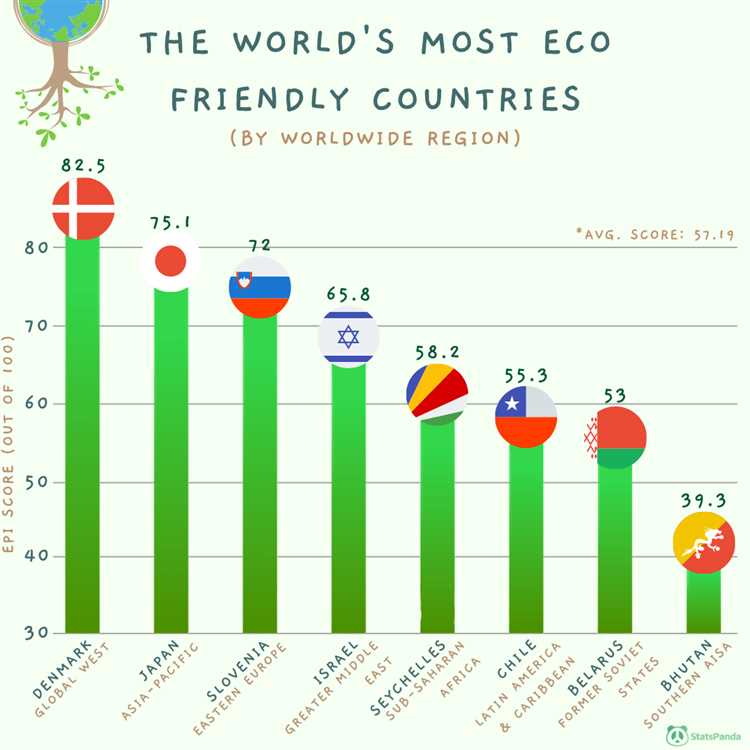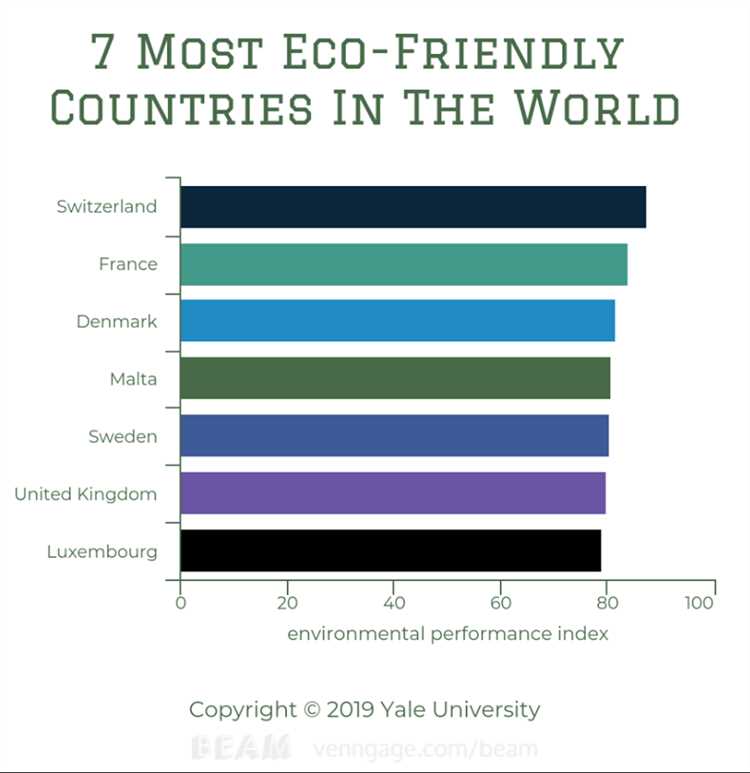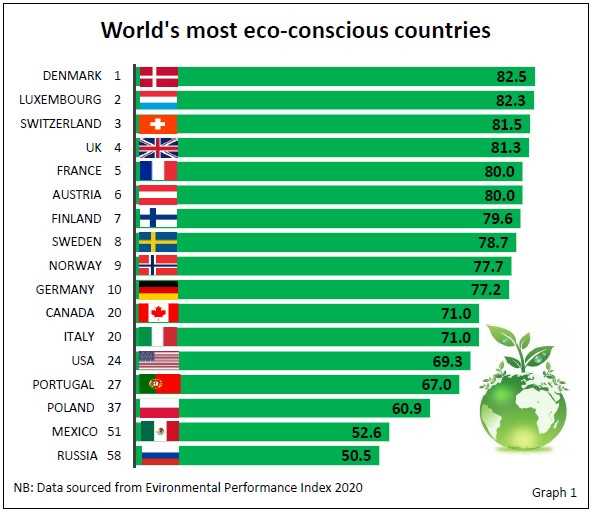
As concerns about climate change and environmental degradation continue to grow, many people are looking for examples of countries that are leading the way in sustainability and eco-friendliness. The question of which country is the most eco-friendly is a complex one, with many factors to consider. However, there are a few countries that consistently rank highly in terms of their commitment to environmental protection and sustainable practices.
One such country is Sweden. Known for its innovative approaches to sustainability, Sweden has made significant progress in reducing its carbon footprint and promoting renewable energy sources. With a strong focus on recycling and waste management, as well as widespread use of electric vehicles and renewable energy, Sweden has become a global leader in the fight against climate change. The country’s commitment to sustainability is evident in the numerous eco-friendly initiatives, from the development of green cities to extensive public transportation networks.
Another country that often tops the list of eco-friendly nations is Denmark. Denmark has long been a proponent of clean energy and sustainable practices. The country has invested heavily in wind energy, making it a global leader in wind power production. Furthermore, Denmark has implemented innovative approaches to urban planning, with a focus on creating pedestrian-friendly cities and promoting cycling as a primary mode of transportation. The country’s commitment to sustainability is demonstrated through its stringent environmental regulations and efforts to reduce greenhouse gas emissions.
Switzerland is another country that has consistently been recognized for its eco-friendliness. The Swiss have a strong commitment to preserving their natural resources and have implemented various measures to protect their environment. The country has made significant investments in renewable energy, particularly hydroelectric power. Additionally, Switzerland has a comprehensive waste management system, with a strong emphasis on recycling and reducing waste. The Swiss also prioritize public transportation, making it easy for citizens to rely on trains, trams, and buses instead of cars.
While these countries are often cited as leaders in sustainability, it is important to recognize that the path to eco-friendliness is not a one-size-fits-all approach. Each country faces unique challenges and has different resources and priorities. Nevertheless, these examples serve as inspiration and demonstrate that progress is possible when there is a collective commitment to protecting the environment.
- Top Eco Friendly Countries in the World
- The Netherlands: Pioneer in Sustainable Living
- Sweden: Leader in Renewable Energy
- Costa Rica: Model for Conservation and Biodiversity
- Protected Areas and National Parks
- Sustainable Tourism
- Renewable Energy
- Educational Programs
- Canada: Commitment to Green Initiatives
- Government Policies and Regulations
- Preservation of Natural Landscapes
- Germany: Promoting Sustainable Development
- Commitment to Renewable Energy
- Efficient Public Transportation
- Finland: Prioritizing Environmental Education
- Questions and answers:
- Which country is considered the most eco-friendly?
- What factors contribute to a country being eco-friendly?
- What are some examples of eco-friendly practices implemented by countries?
- How can a country improve its eco-friendliness?
Top Eco Friendly Countries in the World
When it comes to being environmentally conscious, some countries are leading the way in sustainability and eco-friendliness. These nations have implemented innovative policies and initiatives to protect their natural resources, reduce pollution, and promote renewable energy. Below are some of the top eco-friendly countries in the world:
- Sweden: Sweden is known for its commitment to sustainability and renewable energy. The country has implemented strategies to reduce greenhouse gas emissions, such as investing in wind and solar power. With over 50% of its energy coming from renewable sources, Sweden is well on its way to becoming carbon neutral.
- Switzerland: Switzerland is another country that prioritizes sustainability. It has implemented various environmental regulations and initiatives to protect its stunning landscapes. The country is also known for its excellent waste management and recycling programs, with over 90% of its waste being recycled.
- Denmark: Denmark has made remarkable progress in renewable energy. The country aims to be fully independent of fossil fuels by 2050 and has invested heavily in wind power. Denmark is also known for its commitment to cycling infrastructure and has one of the highest numbers of bicycles per capita in the world.
- Finland: Finland is considered one of the greenest countries in the world. It has set ambitious goals to reduce greenhouse gas emissions and increase the use of renewable energy. Finland is known for its clean air and water, as well as its extensive national park system.
- Norway: Norway is leading the way in sustainable transportation. The country has invested in electric cars and has the highest number of electric vehicles per capita in the world. Norway is also committed to protecting its natural environment and has implemented strict regulations on oil drilling in its waters.
These countries serve as excellent examples of how innovative policies and a commitment to sustainability can make a significant difference in protecting our planet. By following their lead, other nations can work towards creating a more eco-friendly future for generations to come.
The Netherlands: Pioneer in Sustainable Living
When it comes to sustainability and eco-friendly living, the Netherlands stands out as a global leader. With its innovative technologies, progressive policies, and commitment to reducing carbon emissions, the country has made significant strides in creating a greener future.
One of the areas where the Netherlands excels is renewable energy. The country is a frontrunner in wind energy, harnessing the power of its strong winds to generate electricity. Wind turbines can be seen across the Dutch landscape, providing clean and renewable energy to thousands of homes and businesses.
In addition to wind energy, the Netherlands has also invested heavily in solar power. The country has a growing number of solar panels on rooftops and open fields, contributing to its overall energy mix. By promoting the adoption of solar energy, the Netherlands is reducing its reliance on fossil fuels and decreasing its carbon footprint.
Another impressive aspect of sustainable living in the Netherlands is its commitment to sustainable transportation. The country has an extensive network of bike lanes and promotes cycling as a primary mode of transportation. This not only reduces carbon emissions but also improves public health and reduces traffic congestion. In fact, the Netherlands is known for its cycling culture and is often hailed as one of the most bike-friendly countries in the world.
The Netherlands is also known for its innovative architecture and sustainable urban planning. Dutch cities are designed with an emphasis on green spaces, energy-efficient buildings, and sustainable materials. They prioritize public transportation, pedestrian-friendly streets, and encourage residents to use alternative forms of transportation, such as electric vehicles.
Furthermore, the Netherlands has implemented various waste management initiatives to promote recycling and reduce waste. Citizens are encouraged to separate their trash into different categories, including paper, plastic, and organic waste. The country also has a well-established recycling infrastructure, ensuring that recyclable materials are properly processed and reused.
In conclusion, the Netherlands has established itself as a pioneer in sustainable living. Through its commitment to renewable energy, sustainable transportation, innovative architecture, and waste management initiatives, the country has made significant progress in creating a greener and more eco-friendly future.
Sweden: Leader in Renewable Energy
Sweden has established itself as a leader in renewable energy. The country has implemented several policies and initiatives to promote the use of sustainable sources of energy.
One of the key factors contributing to Sweden’s success is its commitment to reducing greenhouse gas emissions. The country has set ambitious targets to reduce its carbon footprint, and has made significant progress in achieving these goals. Sweden has been successful in transitioning away from fossil fuels and towards renewable energy sources such as wind, solar, and hydroelectric power.
Sweden’s investment in research and development has also played a crucial role in its renewable energy sector. The country has fostered innovation in renewable technologies, resulting in the development of efficient and cost-effective solutions. This has not only helped Sweden meet its own energy demands, but has also positioned it as a global leader in renewable energy.
In addition, Sweden has taken steps to promote energy efficiency and sustainable practices in other sectors. The country has implemented strict building codes to ensure energy-efficient construction, and has encouraged the use of public transportation and cycling as alternatives to driving. These initiatives have helped reduce energy consumption and further contribute to Sweden’s eco-friendly reputation.
Furthermore, Sweden’s government has shown strong support for renewable energy. The country provides financial incentives and subsidies for renewable energy projects, making it easier for businesses and individuals to invest in sustainable solutions. This support, paired with favorable policies and regulations, has created a favorable environment for renewable energy development in Sweden.
Overall, Sweden’s commitment to renewable energy, coupled with its investment in research and development, sustainable practices, and government support, has made it a leader in the field. The country serves as an inspiring example for other nations looking to transition to a more sustainable and eco-friendly energy system.
Costa Rica: Model for Conservation and Biodiversity
Costa Rica, a small country in Central America, has become a model for conservation and biodiversity. Despite its size, Costa Rica is home to an astounding amount of biodiversity, making it a paradise for nature lovers and scientists alike.
Protected Areas and National Parks
Costa Rica has made significant efforts to protect its natural habitats by creating protected areas and national parks. These areas cover approximately 25% of the country’s land area, showcasing its commitment to preserving its natural treasures. Famous national parks like Corcovado and Manuel Antonio attract tourists from around the world who come to witness Costa Rica’s incredible wildlife and stunning landscapes.
Sustainable Tourism

Costa Rica is also known for its commitment to sustainable tourism. The country has implemented eco-friendly practices in its hospitality industry, encouraging hotels and resorts to adopt sustainable practices. This includes using renewable energy, reducing waste, and promoting responsible tourism. Visitors to Costa Rica can experience the beauty of the country while minimizing their impact on the environment.
Renewable Energy
Costa Rica is proud to be one of the leading countries in renewable energy production. With an ambitious goal of becoming carbon neutral by 2021, the country has heavily invested in renewable energy sources such as hydropower, wind, and solar energy. Costa Rica’s commitment to clean energy not only helps the environment but also reduces its dependence on fossil fuels.
Educational Programs
Costa Rica understands that educating its citizens about the importance of conservation is crucial for long-term sustainability. The country has implemented educational programs that teach children and adults about the environment, conservation, and the importance of biodiversity. By fostering a sense of responsibility towards their natural surroundings, Costa Rica is shaping future generations to be stewards of the environment.
- Costa Rica is a model for conservation and biodiversity with its protected areas and national parks.
- The country promotes sustainable tourism to minimize the impact on the environment.
- Costa Rica is a leader in renewable energy production.
- Educational programs educate citizens about conservation and biodiversity.
Costa Rica’s commitment to conservation and biodiversity has not only earned recognition globally but also serves as an inspiration for other countries. With its beautiful landscapes, diverse wildlife, and sustainable practices, Costa Rica sets a high standard for eco-friendly living.
Canada: Commitment to Green Initiatives
Canada is widely recognized for its commitment to environmental sustainability and green initiatives. As one of the largest countries in the world, Canada boasts immense natural beauty and resources, which its government and citizens strive to protect and preserve.
Government Policies and Regulations

The Canadian government has implemented a range of policies and regulations to promote eco-friendly practices and reduce carbon emissions. One notable example is the carbon pricing system, which imposes a tax on industries and provinces that do not meet emission reduction targets. This incentivizes businesses to adopt cleaner technologies and encourages individuals to reduce their carbon footprint.
Furthermore, Canada has set ambitious targets for renewable energy generation, aiming to transition to a low-carbon economy. The country has made significant investments in wind, solar, and hydroelectric power, leading to an increase in the production of clean energy.
Preservation of Natural Landscapes
Canada is known for its vast wilderness and pristine landscapes, and the government has made efforts to protect these areas for future generations. National parks and protected areas cover a significant portion of Canada’s landmass, providing habitats for diverse wildlife and promoting conservation. Additionally, sustainable forestry practices are in place to ensure the responsible management of forests and the preservation of biodiversity.
The Canadian government has also implemented measures to protect its coastline and marine environment. With the longest coastline in the world, Canada recognizes the importance of marine conservation and has established marine protected areas and regulations to protect endangered species and ecosystems.
| Environmental Initiatives | Efficiency Rating |
|---|---|
| Clean Energy Investments | 9/10 |
| Carbon Pricing System | 8/10 |
| National Parks and Protected Areas | 10/10 |
| Forestry Management | 8/10 |
| Marine Conservation | 9/10 |
Canada’s commitment to green initiatives is evidenced by its government policies, efforts to preserve natural landscapes, and investments in clean energy. The country continues to set an example for the international community in its dedication to environmental sustainability.
Germany: Promoting Sustainable Development
Germany, known for its commitment to sustainability and renewable energy, has long been recognized as a leader in promoting sustainable development. With a strong focus on reducing carbon emissions and promoting green technologies, Germany has made significant strides towards a greener future.
Commitment to Renewable Energy

One of the key areas where Germany has excelled is in its commitment to renewable energy. The country has set ambitious targets for the expansion of renewable energy sources, with a goal of generating 65% of its energy from renewable sources by 2030. To achieve this, Germany has invested heavily in wind, solar, and biomass energy, leading to a significant reduction in carbon emissions.
Efficient Public Transportation
Germany also boasts an efficient and well-developed public transportation system, which plays a crucial role in reducing greenhouse gas emissions. The country has an extensive network of trains and trams, making it easy for residents and visitors to travel without relying on cars. Furthermore, many cities in Germany have implemented bike-sharing programs and pedestrian-friendly infrastructure, encouraging people to opt for more sustainable modes of transportation.
Green Building Practices
In addition to its focus on renewable energy and public transportation, Germany has also made significant advancements in green building practices. The country has implemented strict building codes and standards that prioritize energy efficiency and sustainability. From energy-efficient insulation and solar panels to innovative designs that maximize natural light and ventilation, German buildings are leading the way in sustainable construction.
In conclusion, Germany’s commitment to promoting sustainable development is evident in its ambitious renewable energy targets, efficient public transportation system, and green building practices. By prioritizing environmental concerns and investing in green technologies, Germany is setting an example for the world in building a more sustainable future.
Finland: Prioritizing Environmental Education

When it comes to being eco-friendly, Finland stands out for its commitment to environmental education. The country has long recognized the importance of educating its citizens about sustainability and the need to protect the environment.
Finland has made environmental education a priority in its school curriculum. From a young age, Finnish students are taught about the importance of recycling, conserving energy, and reducing waste. They learn about the impact of human activities on the environment and are encouraged to take responsibility for their actions.
One of the key reasons behind Finland’s success in environmental education is its emphasis on hands-on learning. Students are encouraged to participate in outdoor activities and learn about the natural world firsthand. They are often taken on field trips to local parks, forests, and lakes, where they can observe and study ecosystems and their interconnections.
Another important aspect of Finland’s environmental education is its focus on interdisciplinary learning. Students are taught about the environment not just in science classes, but also in subjects like geography, history, and even art. This holistic approach helps students develop a deep understanding and appreciation for the environment from multiple perspectives.
Finland’s commitment to environmental education extends beyond the classroom. The country has a strong network of environmental organizations and initiatives that actively involve young people in conservation efforts. These organizations provide opportunities for students to participate in volunteering, advocacy, and sustainability projects.
Overall, Finland’s dedication to environmental education has helped cultivate a culture of sustainability and eco-consciousness among its citizens. By prioritizing education and hands-on learning, Finland has given its younger generations the knowledge and tools to become environmentally responsible adults.
In conclusion, Finland’s emphasis on environmental education has played a significant role in making it one of the most eco-friendly countries in the world. By instilling a sense of responsibility and fostering an understanding of the environment, Finland is paving the way for a greener future.
Questions and answers:
Which country is considered the most eco-friendly?
There isn’t a definitive answer to this question as several countries are leading the way in environmental sustainability. However, some countries often mentioned for their eco-friendly initiatives include Sweden, Denmark, Finland, and Switzerland.
What factors contribute to a country being eco-friendly?
Several factors contribute to a country being eco-friendly. These include the use of renewable energy sources, effective waste management systems, eco-friendly transportation options, conservation efforts, and the promotion of sustainable practices in various sectors.
What are some examples of eco-friendly practices implemented by countries?
Many countries have implemented eco-friendly practices to reduce their environmental impact. Some examples include investing in renewable energy sources like wind and solar power, implementing recycling programs, promoting public transportation and cycling infrastructure, protecting wildlife and natural habitats, and implementing strict environmental regulations.
How can a country improve its eco-friendliness?
A country can improve its eco-friendliness through various measures. Some steps that can be taken include investing in renewable energy infrastructure, implementing stricter environmental regulations, promoting sustainable agriculture and forestry practices, improving waste management systems, encouraging public transportation and cycling, and educating the population about eco-friendly habits and practices.